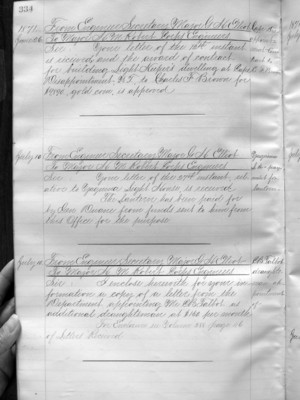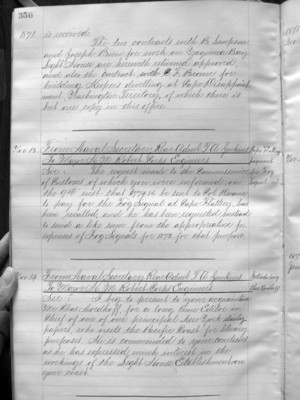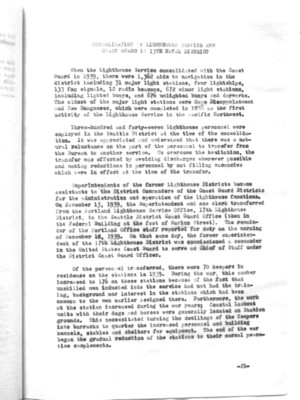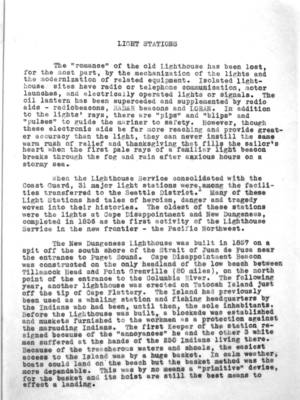Pages That Mention Cape Disappointment
1870-73 Lighthouse Board Annual Reports
22
1871. June 26.
From Engineer Secretary Major G. H. Elliot. To Major H. M. Robert Corps Engineers.
Sir:
Your letter of the 12th instant is received and the award of contract for building Light Keeper's dwelling at Cape Disappointment, W. T. (Washington Territory) to Charles F. Brown for $9,890., gold coin is approved.
July 10.
From Engineer Secretary Major G. H. Elliot. To Major H. M. Robert Corps Engineers.
Sir:
Your letter of the 27th instant, relative to Yaquina Light House, is received.
The Lantern has been paid for by Gen. Duane from funds sent to him from this Office for the purpose.
July 10.
From Engineer Secretary Major G. H. Elliot. To Major H. M. Robert Corps Engineers.
Sir:
I enclose herewith for your information a copy of a letter from the Department appointing Mr. C. B. Talbot as additional draughtsman at $150 per month.
For Enclosure see Volume 288 page 46 of Letters Received.
25
1871.
is received.
The two contracts with B. Simpson and Joseph Bien for work on Yaquina Bay Light House are herewith returned approved and also the contract with C. F. Brown for building Keeper's dwelling at Cape Disappointment, Washington Territory, of which there is but one copy in this office.
Nov. 13.
From Naval Secretary Rear Adml. T. A. Jenkins To Major H. M. Robert Corps Engineers.
Sir:
The request made to the Commissioner of Customs of which you were informed on the 9th inst. that $774.86 be sent to Col. Duane to pay for the Fog Signal at Cape Flattery has been recalled, and he has been requested instead to send a like sum from the appropriation for expenses of Fog Signals for 1872 for that purpose.
Nov. 14.
From Naval Secretary Rear Adml. T. A. Jenkins. To Major H. M. Robert Corps Engineers.
Sir:
I beg to present to your acquaintance Mr. Chas Nordhoff, for a long time Editor in Chief of one of our principal New York daily papers, who visits the Pacific Coast for literary purposes. He is commended to your courtesies as he has expressed much interest in the workings of the Light House Establishment on your coast.
Coast Guard District narrative histories 1945
4
CONSOLIDATION OF LIGHTHOUSE SERVICE AND COAST GUARD IN 13TH NAVAL DISTRICT
When the Lighthouse Service consolidated with the Coast Guard in 1939, there were 1,362 aids to navigation in the district including 31 major light stations, four lightships, 133 fog signals, 12 radio beacons, 672 minor light stations, including lighted buoys, and 676 unlighted buoys and daymarks. The oldest of the major light stations were Cape Disappointment and New Dungeness, which were completed in 1856 as the first activity of the Lighthouse Service in the Pacific Northwest.
Three-hundred and forty-seven Lighthouse personnel were employed in the Seattle District at the time of the consolidation. It was appreciated and understood that there was a natural reluctance on the part of the personnel to transfer from the Bureau to another service. To overcome the hesitation the transfer was effected by avoiding discharges whenever possible and making reductions in personnel by not filling vacancies which were in effect at the time of the transfer.
Superintendents of the former Lighthouse Districts became assistants to the District Commanders of the Coast Guard Districts for the administration and operation of the lighthouse functions. On November 13, 1939, the Superintendent and one clerk transferred from the Portland Lighthouse Service Office, 17th Lighthouse District, to the Seattle District Coast Guard Office (then in the Federal Building at the foot of Marion Street). The remainder of the Portland Office staff reported for duty on the morning of December 18, 1939. On that same day, the former superintendent of the 17th Lighthouse District was commissioned a commander in the United States Coast Guard to serve as Chief of Staff under the District Coast Guard Officer.
Of the personnel transferred, there were 70 keepers in residence on the stations in 1939. During the war, this number increased to 176 on these stations because of the fact that unskilled men inducted into the service had not had the training, background nor interest in the stations which had been common to the men earlier assigned there. Furthermore, the work at the station increased during the war years; Coastal Lookout units with their dogs and horses were generally located on Station grounds. This necessitated turning the dwellings of the Keepers into barracks to quarter the increased personnel and building kennels, stables and shelters for equipment. The end of the war began the gradual reduction of the stations to their normal peactime complements. -22-
11
labor consumed far too much valuable time, and so it became expedient that there be a swifter method. By 1942, Headquarters developed a radio control system for aids to navigation intended primarily for blacking out unattended lighted aids by means of radio signal. The system was designated by the coined word "RACAN" which was later changed to ANRAC to avoid confusion with RADAR beacons or RACONS.
After a thorough study of the use of ANRAC, the District Coast Guard Officer, 13th Naval District, requested Headquarters' authority to install the equipment with the Cape Disappointment Light Station as the control unit for the radio extinguishing of ten buoys in the lower Columbia River. Because of the delay in the delivery of ANRAC equipment, it was not until March, 1944 that the first two ANRAC equipped buoys were placed on station. All maintenance and repair work for this installation of special buoy equipment was handled at the Tongue Point Repair Base, Tongue Point, Oregon. Later at the request of the Commandant, 13th Naval District, the District Coast Guard Officer requested that ANRAC controlled buoys be placed in the Grays Harbor and Willapa Bay areas. Headquarters authorized these installations, but later experiments with ANRAC did not prove satisfactory and permission was requested of Headquarters to discontinue this type of equipment. This request to remove ANRAC equipment from the Columbia River, Grays Harbor, and Willapa Bay was finally approved.
Early in 1943, the Navy had decided to install RACONS on Coast Guard Light Stations at Cape Arago, Cape Blanco, Heceta Head, and Yaquina Head in Oregon. Sixteen Coast Guardsmen were schooled in the operation and maintenance of RACON equipment at a one week training course at the Naval Air Station, Seattle, a short time before the installations were completed. By the end of May, 1943, RACONS were in operation at the above Coast Guard units as well as at the Port Angeles Air Station and the Cape Flattery Light Station.
At the beginning of 1944, the Chief of Naval Operations directed the transfer of all Navy "pulse" equipment to the Coast Guard for operation and maintenance. The first RACON station to be transferred was the installation at Tillamook Naval Air Station which was assumed by the Coast Guard on 1 May, 1945. The stations at Shelton, Quillayute, Whidby Island, and Seattle in the state of Washington, and Astoria, and Oceanside in Oregon were transferred to the Coast Guard. Other RACON units were established subsequently in the 13th Naval District. At the conclusion of the war, various Auxiliary Stations were discontinued and the RACON stations at each were placed in caretaker status.
-28-
20
LIGHT STATIONS
The "romance" of the old Lighthouse has been lost, for the most part, by the mechanization of the lights and the modernization of related equipment. Isolated lighthouse sites have radio or telephone communication, motor launches, and electrically operated lights or signals. The oil lantern has been superceded and supplemented by radio aids - raidobeacons, RADAR beacons and LORAN. In addition to the lights' rays, there are "pips" and "blips" and "pulses" to guide the mariner to safety. However, though these electronic aids be far more reaching and provide greater accuracy than the light, they can never instill the same warm rush of relief and thanksgiving that fills the sailor's heart when the first pale rays of a familiar light beacon breaks through the fog and rain after anxious hours on a stormy sea.
When the Lighthouse Service consolidated with the Coast Guard, 31 major light stations were among the facilities transferred to the Seattle District.¹ Many of these Light Stations had tales of heroism, danger and tragedy woven into their histories. The oldest of these stations were the lights at Cape Disappointment and New Dungeness, completed in 1856 as the first activity of the Lighthouse Service in the new frontier - the Pacific Northwest.
The New Dungeness Lighthouse was built in 1857 on a spit off the south shore of the Strait of Juan de Fuca near the entrance to Puget Sound. Cape Disappointment Beacon was constructed on the only headland of the low beach between Tillamook Head and Point Grenville (80 miles), on the north point of the entrance to the Columbia River. The following year, another lighthouse was erected on Tatoosh Island just off the tip of Cape Flattery. The Island had previously been used as a whaling station and fishing headquarters by the Indians who had been, until then, the sole inhabitants. Before the Lighthouse was built, a blockade was established and muskets furnished to the workmen as protection against marauding Indians. The first Keeper of the station resigned because of the "annoyances" he and the other 3 white men suffered at the hands of the 250 Indians living there. Because of the treacherous waters and shoals, the easiest access to the Island was by a huge basket. In calm weather, boats could land on the beach but the basket method was the more dependable. This was by no means a "primitive" devise, for the basket and its hoist are still the best means to effect a landing.




